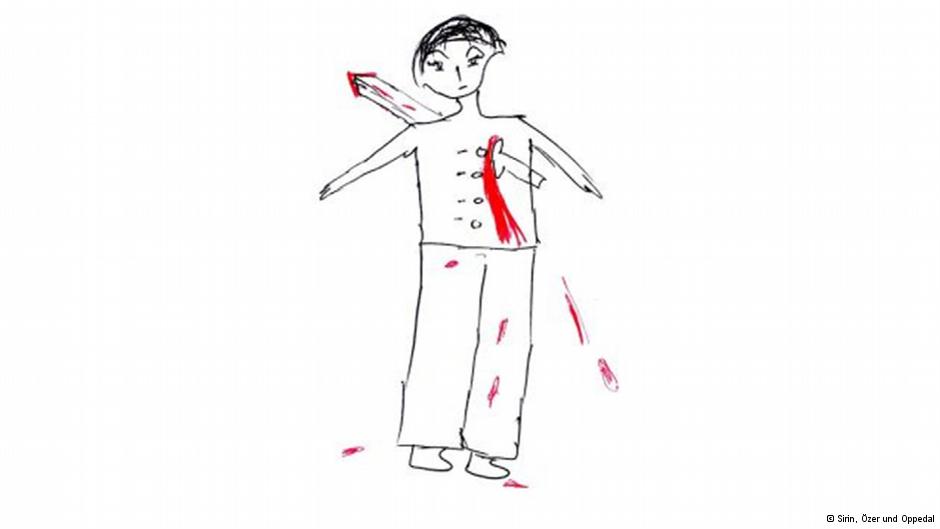The Emotional Scars of the Refugee Children

"When an airplane flies overhead, it scares my son. When he sees rubble on TV, he cries and clutches at his mother. He cries often."
As he speaks, tears rim Mohamad's own eyes. Eight months ago, the 47-year-old engineer and his family fled Syria's civil war. He can hardly put into words the atrocities they experienced there. They're simply too brutal - even for a man as weathered as himself.
Nearly two million people have fled to foreign countries as a result of the Syrian civil war, according to United Nations refugee agency UNHCR. More than half are children.
And yet while they might be fleeing from the war, the refugees don't appear to be escaping it.
Children's drawings

Whoever visits a school for Syrian refugee children will be confronted with drawings of death and desolation: women who cry for their husbands, tanks and army helicopters gunning down small, helpless human beings. There are huge piles of drawings, with black and blood red the dominating colors.
In 2012, researchers from Turkey, the US and Norway asked children in refugee camps to draw a person. Some added blood, tears or weapons to those drawings of their own accord.
"[Syrian children] are growing up with feelings of mistrust, betrayal and anger," wrote the authors of the study, Serap Özer and Selcuk Sirin, in the New York Times.
But at an educational meeting center in Kirikhan, just over the Turkish border, not a trace of blood or tears is to be found. The town of Kirikhan is just 100 kilometers west of Aleppo, Syria. At the BZZ Kirikhan center, which is run primarily by the Turkish branch of a German nonprofit, the Deutschen Volkshochschulverbandes (DVV International), drawings in the hallway made by children show women in head scarves, men wearing ties, many of them smiling and all colorfully framed.
Mohamed's children are attending painting classes here. The bright paints are splashed not only onto paper, but also onto the wall outside the building - and sometimes onto the children's faces, like the two painted hearts on the cheeks of a little girl. Across the forehead, nose and mouth of another boy is a painted Syrian flag.
Strengthening children

Petek Akman is responsible for psychological care at BBZ Kirikhan. Before joining the newly-opened center, she'd worked for six years with the Turkish Red Crescent humanitarian organization, at times in refugee camps. Events such as war are highly traumatic, she says, above all else, when children lose their feeling of security.
"They hear bombs, see how their house is destroyed, and how people die," she told DW. "And often they end up saying, 'My parents can't protect me, either.'"
"But," Akman adds, "children are resilient. They're often tougher than adults."
Since they are not as fully conscious of the consequences of war, she says, they can return more easily to a sense of normality. "Children are open to change."
Of particular importance is strong, familial support. That's also why the BBZ center is in fact aimed more at adults than children.
Professional development courses and language classes are available, and, on a weekly basis, Mohamad stops in to learn Turkish and English. Additionally there are the soccer tournaments, theater classes or communal tea sessions people can attend. One floor above, meanwhile, children romp about the floor on colorful mats.
A place to be
"Make-up" and other activities intentionally distract the children and help relocate them in the present
"People can learn things here that might help them in the future. And they can forget a large part of what they've experienced," said Erdem Vardar, a representative of the German DVV International in Turkey.
More than 200 people have registered for courses at the Kirikhan center, which only opened in mid-August. Through the end of 2013, the center will be financed by the German ministry of development and the humanitarian network of the German protestant church, Diakonie Katastrophenhilfe.
"Education and psychological care take much longer than four or fives months to make an impact," Vardar said. And while many humanitarian organizations in the vicinity provide food, medicines or shelter, "People also need a place where they can wander in and talk to each other," he said.
A place to be, even if far from home. Resolutely, Mohamad wipes away his tears. "I've learned how to calm my son and daughters by hugging them regularly and staying calm, myself," he says, and smiles.
"Some of my neighbors collapsed," he said. "Their kids went hysterical out of pure fear."
But Mohamad wants to be strong. For his son, his daughters - and also for himself.
Monika Griebeler
© Deutsche Welle 2013
Redaktion: Arian Fariborz/Qantara.de